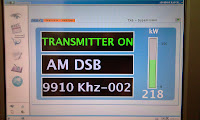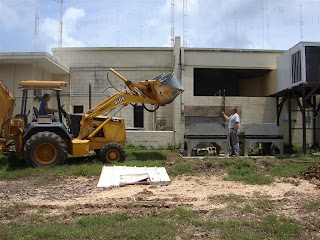We are currently working to make sure we can operate TX6 for many years to come. Much of that work is consumed in locating and aquiring spare parts to fill gaps in our stock room. Once this is done, we can put more effort into getting TX7 on the air. There are some things we can do in TX7 now.

Here is Jeff inserting modules into the modulator section. One reason this was done now is to make room for other equipment in the container in which these were stored. An amazing amount of space can be created just by stuffing parts into these large transmitters.
Speaking of Jeff, he has been on Guam for a few months and will stay into the middle of next year. He will function as the chief engineer while Mike is in the States for his furlough. Jeff will be helped by Phil, a short-termer working as a technician. Short-term help like this is very handy because our permanent staff is so small. We can definitely use more engineers and technicians at KTWR for career and short-term service.

















































